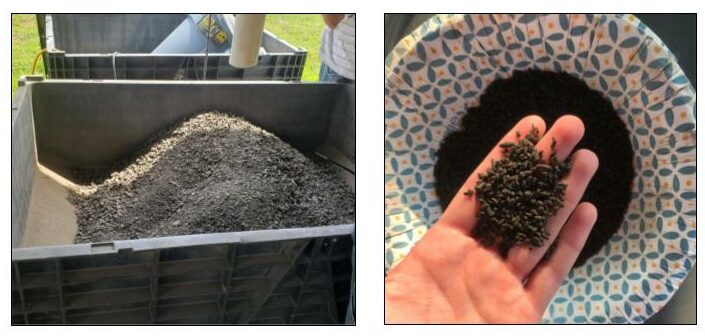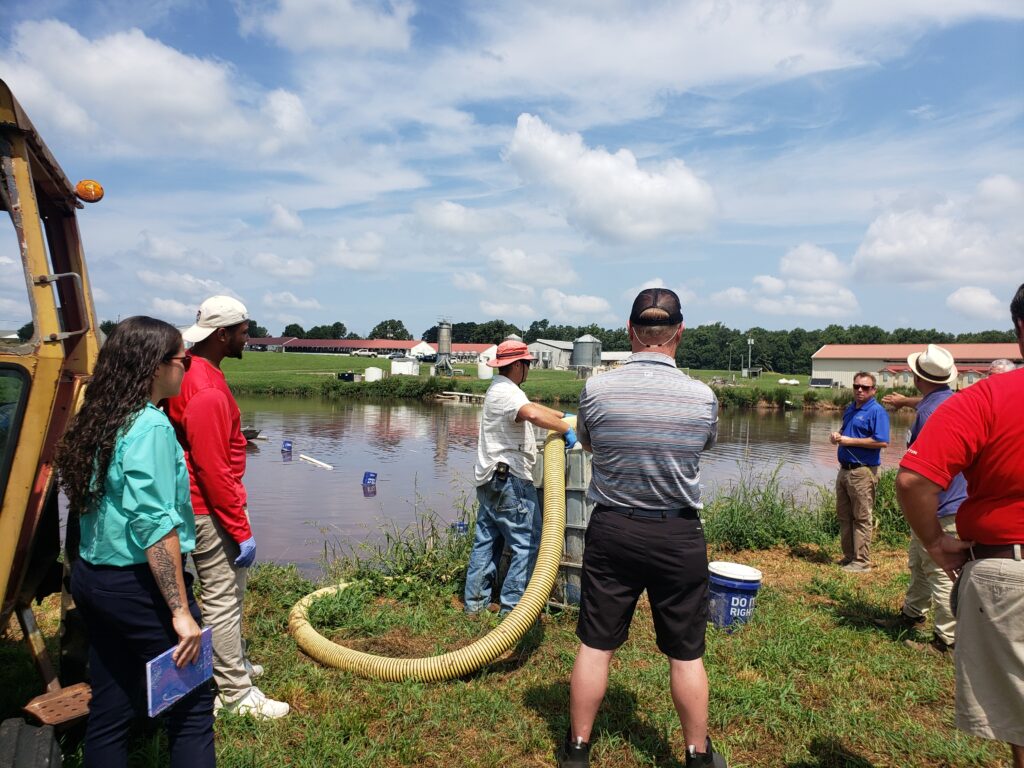Drying Sludge Critical to Improving Nutrient Distribution and Utilization
go.ncsu.edu/readext?812923
en Español / em Português
El inglés es el idioma de control de esta página. En la medida en que haya algún conflicto entre la traducción al inglés y la traducción, el inglés prevalece.
Al hacer clic en el enlace de traducción se activa un servicio de traducción gratuito para convertir la página al español. Al igual que con cualquier traducción por Internet, la conversión no es sensible al contexto y puede que no traduzca el texto en su significado original. NC State Extension no garantiza la exactitud del texto traducido. Por favor, tenga en cuenta que algunas aplicaciones y/o servicios pueden no funcionar como se espera cuando se traducen.
Português
Inglês é o idioma de controle desta página. Na medida que haja algum conflito entre o texto original em Inglês e a tradução, o Inglês prevalece.
Ao clicar no link de tradução, um serviço gratuito de tradução será ativado para converter a página para o Português. Como em qualquer tradução pela internet, a conversão não é sensivel ao contexto e pode não ocorrer a tradução para o significado orginal. O serviço de Extensão da Carolina do Norte (NC State Extension) não garante a exatidão do texto traduzido. Por favor, observe que algumas funções ou serviços podem não funcionar como esperado após a tradução.
English
English is the controlling language of this page. To the extent there is any conflict between the English text and the translation, English controls.
Clicking on the translation link activates a free translation service to convert the page to Spanish. As with any Internet translation, the conversion is not context-sensitive and may not translate the text to its original meaning. NC State Extension does not guarantee the accuracy of the translated text. Please note that some applications and/or services may not function as expected when translated.
Collapse ▲Authors: Carly Graves, Becky Spearman, Mahmoud Sharara
This post summarizes training events that took place on July 21 and 27, 2021, at Lake Wheeler Road Facility farm on the NC State University campus (Figure 1). The training aimed at reviewing new swine lagoon sludge processing technologies to improve nutrient distribution beyond a few miles around swine operations.
Introduction
Swine lagoons require sludge removal to ensure optimal treatment and maintain compliance. Sludge contains high concentration of phosphorus, zinc, and copper (see Table 1 in Sludge Sampling in Anaerobic Treatment Swine Lagoons). This makes finding fields near the farm to utilize these nutrients a challenge. As most swine operations are concentrated in a few counties (Sampson, Duplin, Bladen, and Lenoir), finding suitable land for sludge utilization becomes more challenging. A recent USDA ARS study mapped phosphorus (P) and nitrogen (N) across the U.S. (ArcGIS map) and showed the Carolinas (North and South Carolina) to contain a significant P surplus that require distribution over hundreds of miles to achieve agronomic use.
Current sludge management approaches include pump and haul, bag, excavation and spray, all of which require nearby land application of nutrient-rich sludge. Sludge drying beds were found unsuited for the wet coastal climate in Eastern NC where surplus rainfall severely limits the drying effect. Limitations to these methods is the lack of acreage to utilize the nutrients and the high cost to distribute the nutrients efficiently. Current research activities are focusing on improving on-farm dredging, drying, and composting systems to create value-added products from sludge. This article will summarize highlights from ongoing sludge processing technologies and how they can address this challenge.
Sludge Drying
Before processing sludge, the settled sludge solids must be removed from the lagoon. This is often accomplished by agitating part of the lagoon and loading the mixture to a tanker for land application on nearby fields. Alternatively, sludge is dredged using vacuum or diaphragm pumps at a higher solid concentration, between 5% and 8% solids, then mixed with polymer to dewater in a geotextile bag. The first option is limited by the acres around the farm that can accept sludge slurry with higher P, Zn, and Cu concentrations. The second option, dredging and dewatering, makes it easier to transport these nutrients farther to find suitable acres. However, the dewatering process cost can be significant in addition to the cost of moving dewatered sludge, which still contains 80% water, for application.
For these reasons, drying seems a promising technology to allow for low-cost transportation of these nutrients longer distances for land application. Although drying appears attractive to solve the challenges of sludge management in swine production in Eastern NC, there are no commercially-available farm-scale drying systems for producers to use. Most industrial-scale dryers are capital intensive ($0.5-5.0 million dollars) and require significant operating expenses for electricity and natural gas. A low-cost alternative to achieve sludge drying is relying on greenhouse structures for drying.
Greenhouse Drying
Greenhouses provide adequate surface area to dry dredged sludge and protect it from rainfall (Figure 2). Because of the translucent cover, greenhouses trap solar radiation energy and heat both the wet sludge and the air. Using fans to circulate air increases moisture removal and creates the drying effect. Greenhouse systems can dry sludge from 80-90% moisture to <10% moisture over a few days. They have been used successfully in different locations to dry wastewater treatment sludge (biosolids). Unused structures on farm like poultry houses or tobacco greenhouses can also be converted to sludge drying structures.

Figure 2. Lagoon dredging (left) and temporary storage of removed sludge (middle), and sludge drying in a greenhouse bed (right)
The main features and operational considerations of these greenhouses are:
- Greenhouse area (footprint),
- material loading rate (mass per unit area),
- air circulation (flowrate and on/off controls), and
- material mixing (turning).
These variables control the process duration, overall process efficiency, and cost required for operation in terms of labor and electricity. Air flow inside the greenhouse controls temperature and humidity which are important to achieve efficient drying. Adding ceiling fans or baffles can help ensure airflow is in close contact with sludge to ensure efficient drying. Initial testing of dewatered sludge drying in a dedicated greenhouse drying facility in Florida showed promising results with daily water removal of 1.4 pounds of water per square foot area (Figure 3).
Currently, testing of greenhouse drying performance is ongoing in Duplin County and on NC State’s campus. The evaluated systems accept flowable sludge (~10% total solid), and dewatered sludge (18% to 22% total solids). In flowable sludge, sludge addition and mixing can be accomplished automatically. Dewatered sludge drying on the other hand requires the use of spreaders, tillers, and skid-steers for material handling and mixing. A team of researchers led by Dr. Sharara (Department of Biological and Agricultural Engineering) is evaluating the comparative performance of these solar drying systems and optimizing their operation to increase process efficiency and reduce overall cost of drying.
Pelletized Sludge Product
The biggest question after greenhouse drying is what do you do with the dried sludge after it has reached the desired moisture content (<10% moisture). At this point it is rich in phosphorus, zinc, copper, potassium, etc., and can be a beneficial nutrient source for crop fields. Pelletizing this sludge is a logical step to create a uniform product that can be mixed with other fertilizer products (N and K sources) to create a marketable product (Figure 4). While typical sludge application takes place on land immediately surrounding the lagoon, this pelletized product would allow for transportation across counties.

Figure 4. Dried sludge as it is collected from the greenhouse (left), sample of pelletized sludge product (right)
Conclusion
There is an imbalance of nutrient availability across farmland. Lagoon sludge offers an opportunity to overcome this imbalance by improving its utilization to improve nutrient recycling. Lagoon sludge dredging to dry in greenhouse drying beds is a new approach that can provide farm-scale, affordable sludge processing technology. The final product is a nutrient-rich, low-moisture material that can be pelletized for land application or mixed with fuels for combustion in power plants. The next research question is comparing alternative uses for the dried product that generates the most value and improves nutrient cycling. This will make the technology more affordable to producers for implementation and ensure compliance with permit requirements and statutes regulating swine operations.




